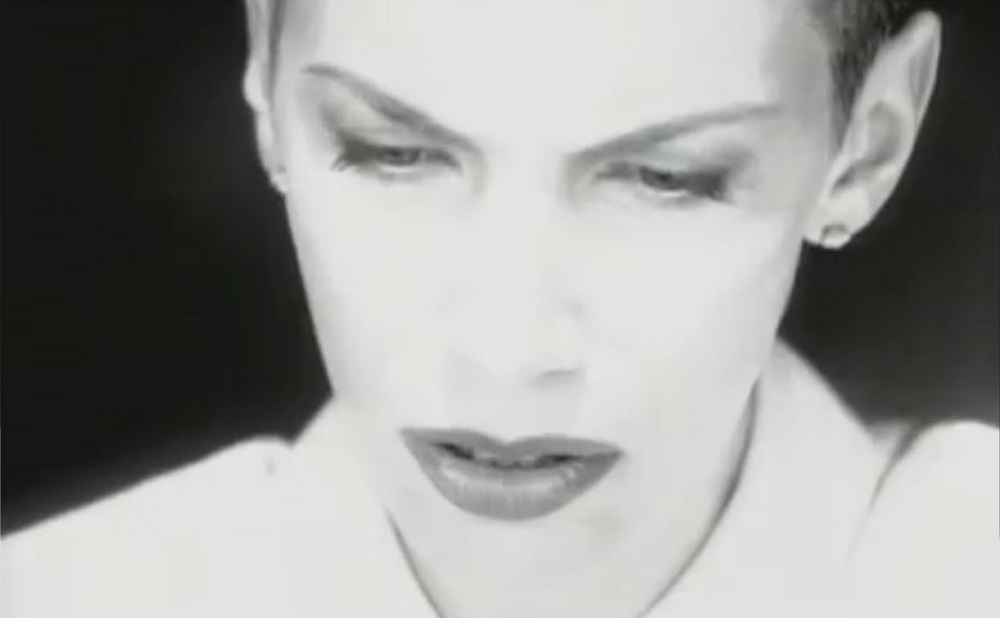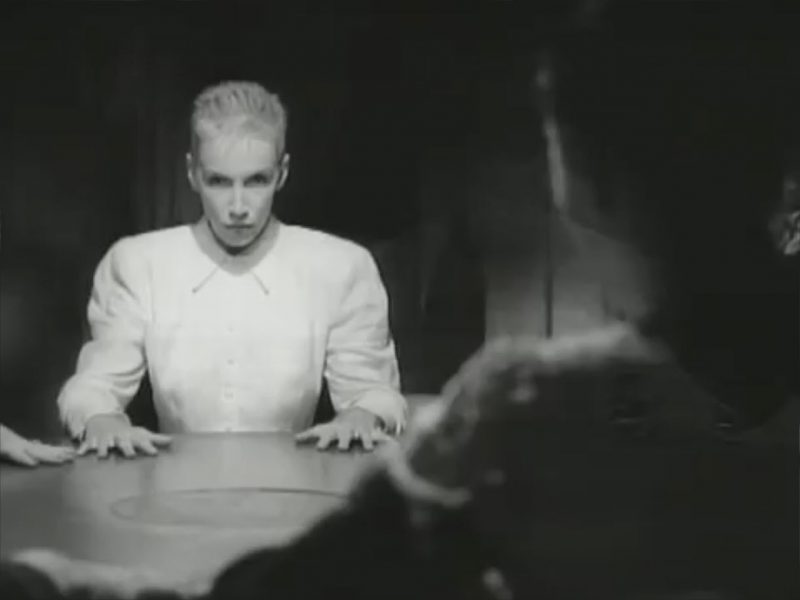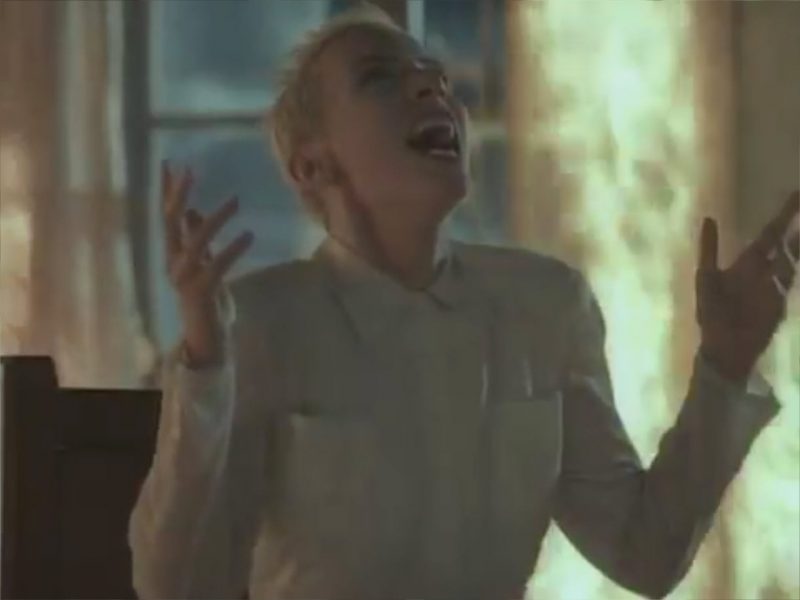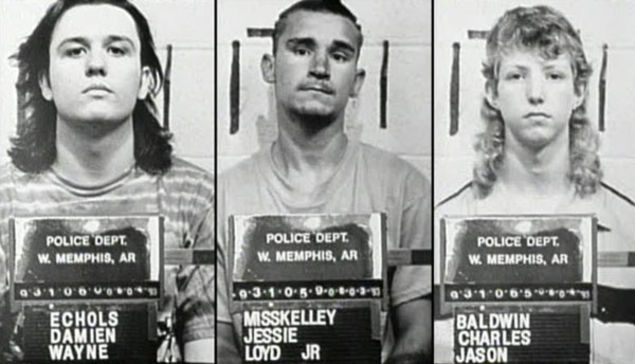
UPDATED: 7/15/2021
With all the weirdness going on today, we felt that this deserved a new look as every 30 years, history seems to repeat itself in the United States.
It’s hard to believe now that singer Annie Lennox came under the MTV ban hammer, but in the late 1980’s there was an embarrassing thing that happened in the United States that was later termed ‘Satanic Panic.’
Yes, it sounds odd now and the stuff of ‘The Crucible,’ and that’s basically what happened for nearly a decade. During this period anything that looked or even sounded occultish would put fear in certain segments of the country.
MTV may now have seemed to be the rebel of the music industry, but they were just as afraid of losing audiences, so they had quite the heavy hand on the censorship button. Annie Lennox felt this mainly when she was with her former band The Eurythmics early on for what was considered ‘too gay’ material in their videos. MTV was very transphobic and Lennox’s look confused them.
With ‘Angel,’ it seems ridiculous that the ‘rebel’ music channel forced Lennox to cut out all scenes that featured a seance or anything that might seem to be of the occult which guts the theme from a very beautiful video which is dealing with death. The video came out in 1989.
As Lennox has said in interviews that the song couldn’t have been the furthest thing from what MTV claimed.
In December 1988, Annie Lennox’ first pregnancy with her second husband, the filmmaker Uri Fruchtman, resulted in a son Daniel, who was tragically stillborn. This song was inspired by Daniel, and also Lennox’ great-aunt, who died at age 57 by committing suicide. In Q magazine, she explained:
“‘Angel’ is sometimes hard for me to sing. It started off as a poem about a great-aunt who had died:
Underneath this canopy of snow
57 winters took their toll
I was fascinated by death. I thought of this concept of a burial place where seasons take their toll – snow covers the grave spot, leaves fall and buds come up – and this woman from my childhood.
The song turned into something else after the death of my first child. But it’s about death generally – I will die; we will all die. Where do we find meaning in our lives?” She further stated that she wished she could ask what had happened to make her aunt take her life, and this video was an extension of that.
So the distributor cut out all the seance scenes for the American version, and it came and went rather quickly as it made no sense and felt very confused. The song ‘Angel’ did well in the UK where they were able to see the full uncut version pushing the video up the charts quickly.
SATANIC PANIC HISTORY:
In the 1980s, allegations of ritual abuse at a preschool in Southern California led to the longest, most expensive trial in U.S. history. The McMartin Preschool case — which resulted in zero convictions — became emblematic of a much more widespread phenomenon known as Satanic Panic.
“In Satanic occultism, that which is good is bad. And that which is bad is good. As you view this learning and educational tape, pay attention to notice the reverse of everything that is normal becoming abnormal.”
Thus begins The Law Enforcement Guide to Satanic Cults, available for viewing on YouTube under the tag “Occult Hilarity” which you can check out above. It’s impossible to know if this 1994 oddity was ever used as an actual police training tool (hopefully not), but it’s presented matter-of-factly. It features input from “experts” like blatantly homophobic “former Satanic priest turned Christian” Eric Pryor (a fascinating guy in his own right), who interprets graffiti and sets up altars, presumably for the benefit of the wide-eyed police officers who suspected their communities were being overrun by a Satanic menace.
The video offers a glimpse at the context that spawned not just the McMartin trial, which ran from 1987 to 1990, but also at the widespread fear that a battle of good versus evil was raging just below the surface of American culture. Heavy metal songs (and the subliminal and backwards messages supposedly contained therein) and album art, horror movies, and fantasy games like Dungeons & Dragons all offered easy, obvious targets. (As seen in the classic TV movie Mazes and Monsters.)
Talk shows, the era’s number-one source for dubious investigations of hot-button topics, also helped fan Satanic Panic’s flames. (Check out the Oprah clip below; the technical quality isn’t good, but the content — in which a calm and clear-eyed representative of an alternative religion calls out an audience member who makes vague claims of having, uh, murdered a guy as part of a Satanic ritual — is very telling.)
“It was something we didn’t realize at the time, but now, it looks like a low-scale version of the McCarthy-era paranoia around communism,” Peter Bebergal, author of Season of the Witch: How the Occult Saved Rock and Roll, tells io9.”The devil worshippers could be anywhere. They could be your next-door neighbor. They could be your child’s caregiver.”
The neurosis went even deeper. Like, conspiracy-theory deeper, a gift of crazy that’s kept on giving. Bebergal has a few theories as to Satanic Panic’s titanic rise:
“A lot of it was having a spiritual vacuum, created by the fact that the 1960s promise of this cosmic, spiritual consciousness didn’t really pan out. Then you had this 1970s uptick of paranormal investigations, ESP, an interest in UFOs, really climaxing with Close Encounters of the Third Kind. But the aliens never actually landed, you know?
I think it led to a cynicism that led to kind of a cultural paranoia: there is no meaning. There was already an uptick in fundamentalist Christianity. The Reagan Right had begun to dominate politics. And it was the beginning of a cultural war; that’s when the Parents Music Resource Center started to put labels on album covers to warn against profanity or even references to the occult. It was a perfectly ripe stew for [Satanic Panic.] In a way, believing that Satan is running the world is still [offering] a kind of order to things, in a world that can feel very disorderly.”
In the wake of all this paranoia came a slew of high-profile cases involving day-care workers, which were a perfect storm of paranoia about Satanism, cutting-edge psychotherapy that claimed to recover the children’s repressed memories, and a gathering awareness of the problem of child sexual abuse. It’s important to remember that the 1980s didn’t just see unfounded dread about Satanists. Prior to the late 1970s, law enforcement did very little to prosecute sexual abuse of children. But in the 1980s, the Department of Justice stepped up its fight against child pornography, with measurable success, and laws revolving around the reporting of child abuse were revamped, with an eye toward protecting innocent victims.
So these allegations of ritual abuse in day-care centers came from the combination of legitimate awareness of a previously hidden problem, and completely unfounded hysteria. As Georgetown Professor John Myers explained to PBS‘s Frontline:
Child sexual abuse (CSA) was never completely ignored by the American legal, medical, and child protection systems. Nevertheless, until the late 1970s and early 1980s, CSA was largely a hidden phenomenon. At the time the day-care cases arose, society was just beginning to acknowledge and come to terms with sexual abuse of children. Thus, the day care cases did not come to the surface all by themselves. Rather, the day care cases were part of the broader societal awakening to CSA. The day care cases captured our attention for several reasons. First, the children were very young and vulnerable. Second, some of the allegations were bizarre and fantastic. Third, some of the alleged offenses were unspeakably horrible. Fourth, with so many American children in day care, many parents could relate to these cases. Finally, the interviewing in some of the large day care cases was clearly defective.
A lot of the interest in patients claiming to have recovered buried memories of Satanic ritual abuse began with a 1980 book entitled Michelle Remembers, written by psychiatrist Lawrence Pazer and his patient (and later, wife) Michelle Smith, says Pamela Freyd, PhD, the executive director of the False Memory Syndrome Foundation, a nonprofit (met with some varying opinions in the scientific community) that mostly works with parents who have been accused of childhood abuse by their now-adult children. (Freyd and her husband have firsthand experience with this.)
Pazer and Smith’s book Michelle Remembersrecounted how Smith’s therapy dislodged sensational “memories” of being abused as a small child by a Satanic cult, spawning a best-seller that was initially accepted as fact. And though it was later discredited, “that book played a role in the McMartin case, and the topic seemed to be everywhere because of the extensive coverage of that case,” Freyd tells io9.
Although the McMartin case — in which a preschool director and her son faced 52 counts of molesting their students — was not the only one of its kind, it was by far the most high-profile.
A January 1990 New York Times article recounted the controversial case, noting that the not-guilty verdicts were “the final leg of a legal marathon that drew national attention, not only for its extraordinary length and complexity but also for the difficult questions it raised about the prosecution of child molestation cases, the reliability of children’s testimony and whether the news media stirred emotions when the charges surfaced.”
The children, the jury believed, were unreliable witnesses. The Satanically-inflected details that emerged were so shocking (children were “frightened into silence with bloody animal mutilations;” forced to watch “a rabbit sacrificed on a church altar,” “a parakeet squeezed to death,” and a pony killed before their eyes) they were found to be unbelievable.
Looking back, the McMartin case seems like a clear-cut case of mass hysteria. But even after it was closed, fears about Satanic ritual abuse refused to completely die. In 1993, a year before The Law Enforcement Guide to Satanic Cults found its way to VHS, the long saga of the West Memphis Three began, in which a trio of young men were accused of murdering a trio of young boys as part of a cult ritual.
The West Memphis Three case was one I personally became involved with after hearing about it so much from Henry Rollins back in 2001. From the outset, it appeared that the trio were guilty but once looking at all the materials involved with the case, things were definitely not what they seemed.
I spent several years getting to work with the people behind the WM3 support site along with many of the people involved in the case directly like John Fogelman and Damien Echols wife Lori. Lori acted as a go-between for myself with any direct questions I had for Damien Echols which only helped make the script for “West Memphis Three” stronger as we talked to everyone on both sides of this controversial case.
As with so many movies in development, things sadly didn’t work out even though we had support from a stellar cast, but something even better came out of all my hard work. As our project had numerous mentions in the mainstream press because of the cast that was involved, filmmaker Peter Jackson (Lord of the Rings, The Hobbit) became aware of the case and hired private investigators to help behind the scenes.
You can read our script which was praised by everyone involved with the West Memphis Three case for not taking sides but presenting a story that seems more like fiction the fact. The sad thing is that it can easily happen again as has been seen in the Stephen Avery case.
In 2008 Damien Echols, Jason Baldwin and Jessie Misskelley Jr were freed after taking an Alfred plea.
“[The police] had this whole thing about how the teenagers were into the occult,” author Bebergal remembers. “But in the court documents, they would always make note that they listened to heavy metal. That was a key point. The music that they listened to, it was believed, would make them more susceptible to whatever Satanic conspiracy. It was a way of noting that the kids were troubled.”




